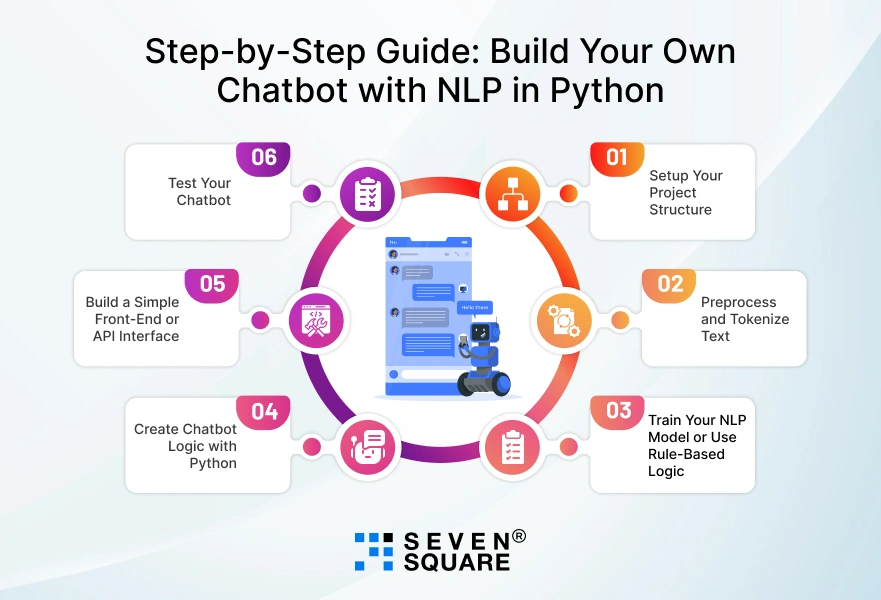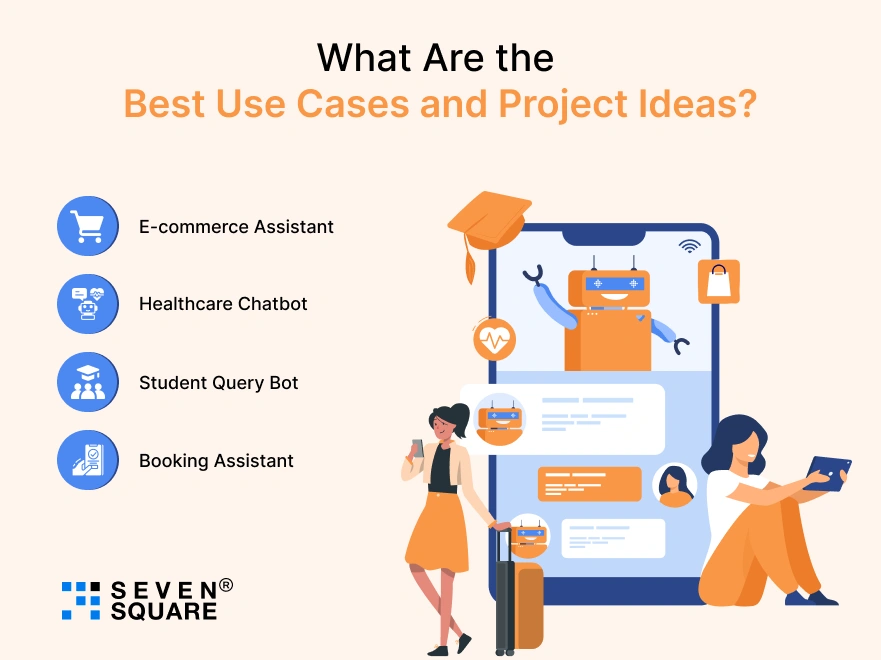Nowadays, customers expect instant answers, whether it’s shopping, booking services, or getting support.
This is where a chatbot with NLP in Python becomes a game-changer.
These intelligent bots can understand, interpret, and respond to human language to make your customer interactions smarter and more efficient.
From virtual assistants like Siri and Alexa to customer support bots in e-commerce or healthcare, NLP chatbots are being used across industries to reduce manual workload, improve response time, and drive user engagement 24/7.
But why use Python?
Python is one of the best languages to build an NLP chatbot due to its clean syntax, vast library ecosystem, and flexibility.
With tools like NLTK, spaCy, and TensorFlow, building smart chatbots is easier and faster than ever.
In this blog, you can learn about a step-by-step tutorial to build your own chatbot with NLP & Python code examples that you can use directly.
What Is Natural Language Processing (NLP) in Chatbots?
When we talk about a natural language processing chatbot in Python, we mean a bot that can understand & respond to human conversations in a way that feels natural.
NLP stands for Natural Language Processing, a branch of AI that enables machines to understand, interpret, and generate human language.
In chatbots, NLP allows the system to:
- Detect user intents
- Understand the meaning of phrases
- Generate human-like responses
For example, when a user says, “I want to order pizza,” an NLP chatbot can extract the intent (ordering) and the entity (pizza), and respond accordingly.
Here are some of the most popular Python NLP libraries:
- NLTK (Natural Language Toolkit): Great for text processing and prototyping.
- spaCy: Fast, production-ready NLP toolkit.
- Transformers (Hugging Face): For deep learning models like BERT and GPT.
With these tools, your chatbot becomes much more than a rule-based responder, it becomes a smart assistant.
What Are the Tools & Libraries You’ll Need to Build a Chatbot with NLP?
To build the best NLP chatbot in Python, you’ll need a few essential tools and libraries that are widely used and beginner-friendly.
Must-Have Tools:
- Python 3.13: The programming language we’ll use.
- NLTK or spaCy: For text preprocessing, tokenization, and intent recognition.
- Flask: To build an API or a simple front-end interface.
- Git & GitHub: For version control and sharing your project online.
Optional (But Powerful):
- Rasa: Great for advanced conversational AI.
- Transformers (Hugging Face): For using models like BERT or GPT-2.
- Streamlit: To create a clean and interactive chatbot UI without front-end code.
These are some of the best Python libraries for building an NLP chatbot, easy to learn and powerful enough for real-time production use.
Tips to Improve Your NLP Chatbot Accuracy
Building a working chatbot is one thing making it smart, accurate, and real-time is another.
Here are some tried-and-tested tips to enhance your bot’s performance:
- Define Clear Intents and Entities: Mapping user input to intents (what the user wants) & entities (specific data points) helps your chatbot reply precisely.
- Integrate Sentiment Analysis: Want your bot to react empathetically? Use sentiment analysis to detect the user’s mood & customize responses accordingly.
- Use Pre-Trained Transformer Models: Use Hugging Face Transformers like BERT or GPT to bring deep learning into your chatbot and handle complex queries with high accuracy.
These techniques make a huge difference, especially when you’re building a real-time Python NLP chatbot for serious business use.
Step-by-Step Guide: Build Your Own Chatbot with NLP in Python

Wondering how to build a chatbot with NLP in Python step by step?
You can go through the entire process from setting up your files to testing a working chatbot.
Step 1: Setup Your Project Structure
Start by creating a clean directory for your project:
mkdir nlp-chatbot-python
cd nlp-chatbot-python
Copied!
Create these files inside your folder:
/nlp-chatbot-python
├── app.py
├── train.py
├── chatbot.py
├── intents.json
├── requirements.txt
Install required libraries:
pip install nltk flask
Copied!
If using spaCy:
pip install spacy
python -m spacy download en_core_web_sm
Copied!
Step 2: Preprocess and Tokenize Text (Using NLTK or spaCy)
Let’s load your data and preprocess it using NLTK. Create train.py:
import json
import nltk
import random
import pickle
import numpy as np
from nltk.stem import WordNetLemmatizer
from sklearn.feature_extraction.text import CountVectorizer
from sklearn.naive_bayes import MultinomialNB
nltk.download('punkt')
nltk.download('wordnet')
lemmatizer = WordNetLemmatizer()
with open("intents.json") as file:
data = json.load(file)
corpus = []
labels = []
classes = []
for intent in data['intents']:
for pattern in intent['patterns']:
tokens = nltk.word_tokenize(pattern)
tokens = [lemmatizer.lemmatize(w.lower()) for w in tokens]
corpus.append(" ".join(tokens))
labels.append(intent["tag"])
if intent["tag"] not in classes:
classes.append(intent["tag"])
Copied!
Step 3: Train Your NLP Model or Use Rule-Based Logic
Add this to train.py to vectorize and train your model:
vectorizer = CountVectorizer()
X = vectorizer.fit_transform(corpus).toarray()
y = np.array(labels)
model = MultinomialNB()
model.fit(X, y)
with open("model.pkl", "wb") as f:
pickle.dump(model, f)
with open("vectorizer.pkl", "wb") as f:
pickle.dump(vectorizer, f)
with open("classes.pkl", "wb") as f:
pickle.dump(classes, f)
Copied!
Now you’ve trained your first NLP chatbot in Python using scikit-learn and NLTK!
Sample intents.json
{
"intents": [
{
"tag": "greeting",
"patterns": ["Hi", "Hello", "Hey"],
"responses": ["Hello!", "Hi there!", "Hey!"]
},
{
"tag": "bye",
"patterns": ["Bye", "Goodbye", "See you"],
"responses": ["Bye!", "Take care!", "Goodbye!"]
}
]
}
Copied!
Step 4: Create Chatbot Logic with Python
Create chatbot.py:
import pickle
import random
from nltk.stem import WordNetLemmatizer
import nltk
lemmatizer = WordNetLemmatizer()
model = pickle.load(open("model.pkl", "rb"))
vectorizer = pickle.load(open("vectorizer.pkl", "rb"))
classes = pickle.load(open("classes.pkl", "rb"))
with open("intents.json") as file:
data = json.load(file)
def predict_intent(sentence):
sentence = " ".join([lemmatizer.lemmatize(w.lower()) for w in nltk.word_tokenize(sentence)])
X = vectorizer.transform([sentence]).toarray()
prediction = model.predict(X)[0]
return prediction
def get_response(intent):
for i in data['intents']:
if i["tag"] == intent:
return random.choice(i["responses"])
Copied!
Step 5: Build a Simple Front-End or API Interface
Use Flask to build a simple web interface in app.py:
from flask import Flask, request, jsonify
from chatbot import predict_intent, get_response
app = Flask(__name__)
@app.route("/chat", methods=["POST"])
def chat():
user_input = request.json["message"]
intent = predict_intent(user_input)
response = get_response(intent)
return jsonify({"response": response})
if __name__ == "__main__":
app.run(debug=True)
Copied!
Test using Postman or a basic HTML form.
Step 6: Test Your Chatbot
Run the Flask app:
python app.py
Copied!
Send a POST request to http://localhost:5000/chat with:
{
"message": "Hello"
}
Copied!
And you’ll get a chatbot response like:
{
"response": "Hi there!"
}
Copied!
You’ve now built a working chatbot with NLP in Python step by step.
Here’s the Complete code to build chatbot with NLP in Python.
How to Deploy Your NLP Chatbot?
Once your chatbot works locally, it’s time to show the world!
Here’s how to deploy your NLP chatbot using Python and Flask.
Deploy Using Flask + Heroku (or Render)
1. Create a Procfile:
web: gunicorn app:app
Copied!
2. Add gunicorn to requirements.txt:
flask
nltk
scikit-learn
gunicorn
Copied!
3. Commit your project to GitHub.
4. Deploy on:
How We Can Help to Build Your NLP Chatbot in Python?
When it comes to building a smart, scalable, and reliable chatbot with NLP in Python, Seven Square is your trusted development partner.
We build intelligent conversational solutions that understand your users, automate workflows, and improve your business experience.
Our NLP Chatbot Development Expertise:
- Custom Chatbot Solutions: Whether you need a customer service chatbot, a healthcare assistant, or an e-commerce bot, we build custom solutions by using natural language processing (NLP) and Python.
- End-to-End Development: From intent recognition and entity extraction to chatbot logic, UI, and deployment, we handle the full cycle including training your bot with real data and integrating it with your existing systems.
- Real-Time & Multi-Platform Integration: Want to connect your NLP chatbot to web, mobile, WhatsApp, or Slack? We make it happen with a secure, smooth, and user-friendly experience.
Want to build a chatbot with NLP in Python? Contact Us Now!
What Are the Best Use Cases and Project Ideas?

Thinking about how your NLP chatbot can be useful? Here are a few project ideas for different industries and business needs:
- E-commerce Assistant: Answer product queries, check order status, or help users navigate your store automatically.
- Healthcare Chatbot: Allow patients to book appointments, ask health questions, or get medication reminders, all through conversation.
- Student Query Bot: Help students’ access timetables, exam dates, or course content via an AI-powered assistant.
- Booking Assistant: Let users make hotel, flight, or cab bookings by simply chatting with your bot to save time and improve UX.
Whether you’re a startup founder or enterprise team, these ideas can help you innovate faster and deliver better service.
FAQs
- An NLP chatbot in Python is an intelligent conversational agent built using Natural Language Processing (NLP) techniques.
- It can understand human language, detect intent, and respond meaningfully.
- Python libraries like NLTK, spaCy, and scikit-learn make it easier to build such bots efficiently.
- Yes, you can build a rule-based chatbot using Python without machine learning.
- However, NLP-powered bots using ML offer better accuracy, understanding of user intent, and conversational flexibility.
- Yes, you can deploy your chatbot using Flask, Django, or FastAPI and connect it to web or mobile apps via APIs.
- For real-time UIs, use tools like Streamlit or integrate with platforms like WhatsApp, Messenger, or Slack.
- Python offers:
- Simple syntax
- Strong NLP and ML libraries
- Rapid development
- Active developer community
- These make it the top choice to build NLP chatbots quickly and reliably.